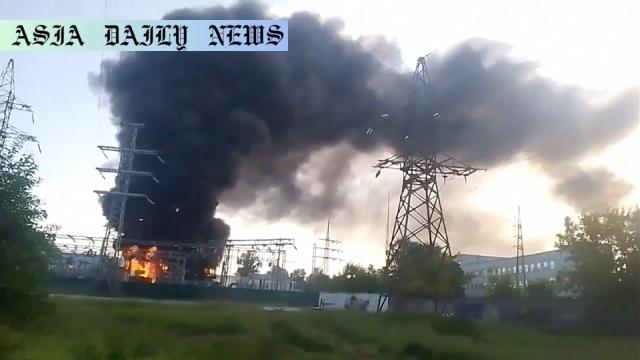Ukraine appears to have intensified its attacks on military facilities in Russia following its recent ‘Spider Web’ operation.
Ukraine intensifies strikes on Russian military facilities after ‘Spider Web’ operation.
Targets include air defense and missile production factories in Russia.
Germany considers providing Patriot systems amidst US weapon delays.
Russia increases military pressure near Eastern Ukraine’s Pokrovsk.

Ukraine Increases Long-Range Strikes on Strategic Russian Facilities
Ukraine has significantly escalated its offensive against Russian military targets following its groundbreaking ‘Spider Web’ operation in June. The carefully strategized campaign has showcased Ukraine’s ability to conduct long-range attacks, sending shockwaves across the defense landscape in Russia. The most recent noteworthy move was an attack on July 1, targeting a facility in the Chuvash Republic, known for producing critical components for drones and missiles. Simultaneously, a drone strike in Izhevsk targeted another facility specializing in air defense systems and attack UAVs.
The June 1 ‘Spider Web’ initiative carried out by Ukraine profoundly influenced the dynamics, as it reportedly incapacitated dozens of Russian bombers. These developments highlight the significant scope of Ukraine’s evolving military capabilities, particularly in leveraging drone technology to disrupt Russia’s defense infrastructure. Experts suggest that such maneuvers aim to limit Russia’s forward capabilities while putting political and logistical pressure on Moscow’s military-industrial framework.
Strategic Ramifications in Europe Amid Weapon Supply Dynamics
The cascading effects of Ukraine’s intensifying strikes bring to light broader geopolitical maneuverings. Germany, for instance, has expressed its intent to procure additional Patriot defense systems from the United States to bolster Ukraine’s defenses. Discussions surrounding this potential acquisition reflect the urgency of strengthening air defense networks in the region. Bloomberg has confirmed that Germany is in advanced negotiations and considers this move vital in shielding Ukraine from further escalation. Chancellor Friedrich Merz and US President Donald Trump recently emphasized their commitment to reinforcing Ukraine’s military resilience as part of ongoing NATO strategies.
This has occurred as the United States reportedly paused certain weapon deliveries to Ukraine, emphasizing the urgency for European allies to step in. Germany’s actions may serve as a leading example, reflecting Europe’s readiness to adapt and rapidly transform its approach to supporting Ukraine’s sovereignty in these crucial times.
Russia Mounts Counter-Moves Targeting Eastern Ukraine
On the flip side, Russia continues to ramp up its aggression in Eastern Ukraine, notably around Pokrovsk, which serves as a key transit hub. Encirclement strategies reportedly aim to leave crucial Ukrainian defense positions isolated, impinging on their supply chains. The Institute for the Study of War has expressed concern over these maneuvers, predicting a potential intensification of Russian offensives in the months ahead.
In response, Ukraine has turned to its Western allies for sustained support, recognizing that their continued investments will be integral to withstanding Russian advances. While the spotlight shines on high-profile military attacks and countermeasures, the social and humanitarian costs remain a significant cause for worry. Efforts to support displaced populations and rebuild communities in war-torn Ukrainian provinces will likely require long-term commitments from international coalitions.
The Confluence of Tactical Strikes and Diplomatic Alliances
As military strikes from Ukraine reverberate across Russia, the geopolitical stage is fraught with shifting alliances, diplomatic urgencies, and tactical recalibrations. With the apparent success of operations like ‘Spider Web,’ Ukraine is not only reinforcing the morale of its allies but also sending a strong message about its capacity for offensive innovation. However, these actions come with risks—risks that force European and Western allies to work toward mitigating broader escalations.
From an aerial-dominance perspective, the acquisition of advanced technology such as Patriot defense systems could serve as a quintessential game-changer. In addition to battlefield strategies, maintaining diplomatic cohesion across NATO and other European partners will require careful negotiation, particularly amid ongoing shifts in global power balances.



Commentary
Ukraine Shows Tactical Innovation Through ‘Spider Web’
The recent reports highlighting Ukraine’s intensified attacks on Russian defense infrastructure illustrate a tactical shift in the ongoing conflict between the two countries. Leveraging advanced drone technology and intricate operational planning, Ukraine has demonstrated its capacity for long-range, precision-based attacks. For a nation under significant strain due to continued aggression, such innovation underscores both resilience and adaptability. This has rightfully drawn the attention of the international community, with experts lauding Ukraine’s strategic foresight in disrupting its adversary’s supply chains.
Germany’s Support Reinforces Europe’s Role
Germany’s decision to actively support Ukraine by potentially delivering advanced Patriot air defense systems marks a critical moment in the Western response to the crisis. As weapons shipments from the United States experience interruptions, the European contribution emerges as an integral factor in maintaining momentum on Ukraine’s side. The significance of these discussions cannot be overstated, as they represent not just a material offering but a testament to Europe’s steadfast unity. The coming months will reveal whether such measures are enough to counterbalance not just the aggressions witnessed on the battlefield but also the political uncertainties permeating Europe and beyond.
Global Stakes in Ukraine’s Battle for Sovereignty
The Ukraine conflict serves as a stark reminder of how regional wars can reverberate across global platforms. From military hardware negotiations to humanitarian aid and economic sanctions, the international response reflects the multidimensional nature of this crisis. Ukraine’s bold maneuvers, paired with sustained international support, will undoubtedly alter the course of the ongoing conflict, but there are broader implications. These strike not only at the heart of Russian military-industrial complexes but also at the cohesion of international diplomatic frameworks striving to bring about stability.